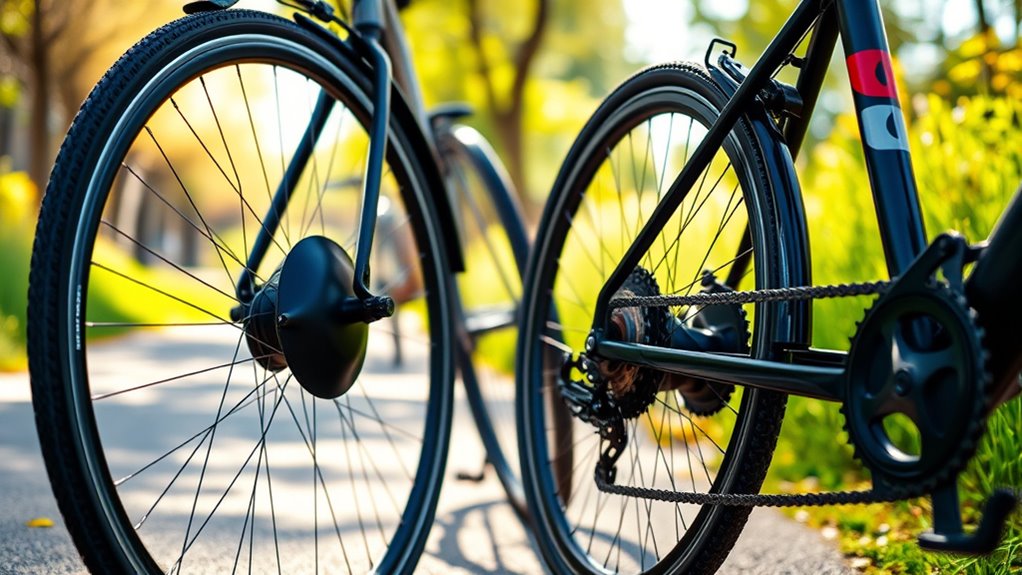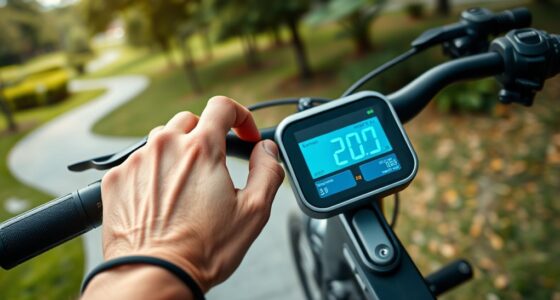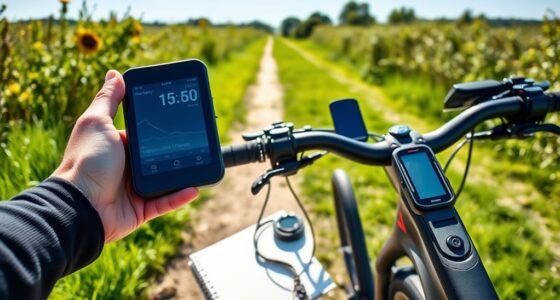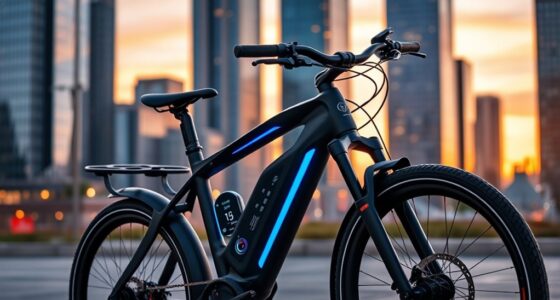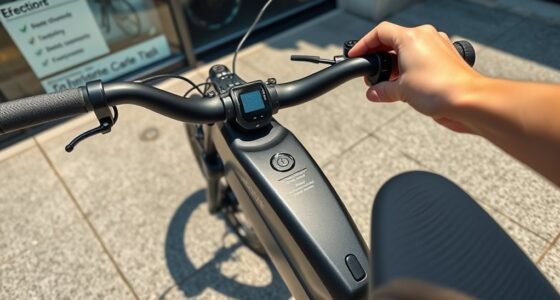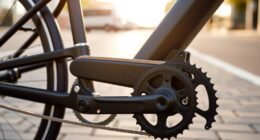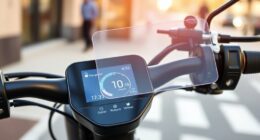When choosing an e-bike motor, you’ll find hub motors are simple, efficient, and low-maintenance, ideal for flat terrains and a sleek look. Mid-drive motors, on the other hand, are positioned at the crank and excel at climbing hills, offering better power distribution and handling. Each type has its benefits based on your riding style and terrain. If you want to explore more about how these motors compare, keep exploring further.
Key Takeaways
- Hub motors are integrated into the wheel hub, offering simplicity, low maintenance, and smooth power delivery.
- Mid-drive motors are located near the crankset, working with gears for better efficiency on hills and varied terrains.
- Hub motors excel on flat terrain with quieter operation, while mid-drive motors handle hilly areas more effectively.
- Hub motors have fewer moving parts, making them more durable; mid-drive motors involve complex gear interactions.
- Choose hub motors for low maintenance and sleek design, or mid-drive motors for improved torque and hill-climbing performance.
How Hub Motors Power Your Ride
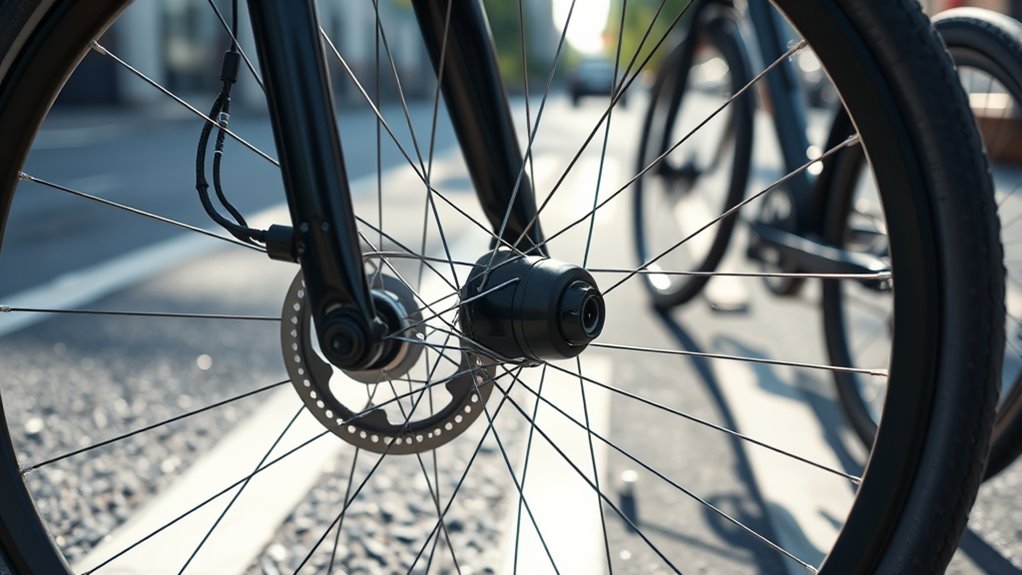
Hub motors are a popular choice for e-bikes because they integrate directly into the wheel hub, making them simple and efficient. With the motor located inside the wheel, your bike’s power delivery feels smooth and direct. The placement of the motor also affects battery placement; since the motor is centralized within the wheel, the battery is usually mounted on the frame or rear rack to balance the weight. This design keeps wiring straightforward and maintenance easy. Because the motor is embedded in the wheel, you won’t need to worry about complex gear systems or chain drives. This setup offers a clean look and reliable performance, making hub motors ideal for riders seeking a hassle-free, low-maintenance e-bike experience. Additionally, cost considerations often make hub motors a more affordable option compared to other motor types.
The Mechanics of Mid-Drive Motors
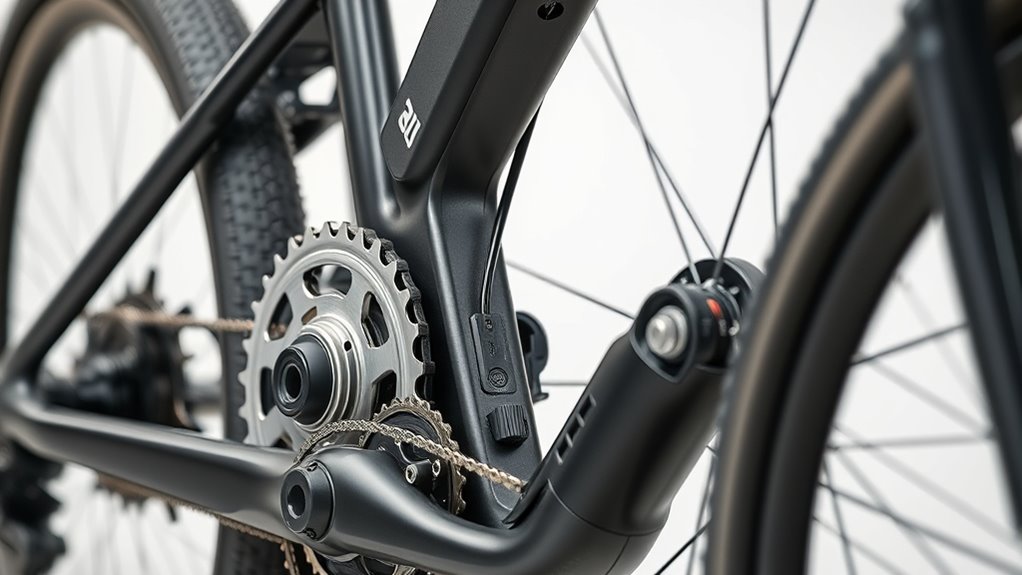
Mid-drive motors are positioned at the center of your bike’s frame, near the bottom bracket, directly engaging the crankset. This motor placement allows for better leverage and efficiency, especially on hilly terrain. The key to their mechanics lies in how they work with your bike’s gears. Because the motor drives the crankset, you can shift gears to optimize power output and conserve battery life. The motor’s placement also enables smoother handling and balanced weight distribution. Understanding gear ratios is vital, as they determine how much assistance you get at different speeds and pedaling intensities. Additionally, mid-drive motors often feature integrated sensors that precisely adjust power based on your pedaling effort. Moreover, awareness of the AI Security concerns related to such technologies can help in understanding their vulnerabilities and ensuring safe deployment. Overall, their mechanics provide a natural riding feel and versatile performance.
- Engages with your bike’s existing gear system
- Uses gear ratios to optimize power
- Positioned at the bike’s center for balance
- Provides smooth, responsive assistance
- Enhances efficiency on varied terrains
Comparing Performance and Efficiency

When evaluating e-bike motors, performance and efficiency often depend on how well the motor converts energy into useful assistance while minimizing power loss. Hub motors tend to be more efficient in flat terrains because their battery placement at the wheel reduces drivetrain losses. They’re also quieter, producing less noise during operation. Mid-drive motors, located near the crank, excel on hilly terrain by leveraging the bike’s gears, which can improve overall efficiency. However, they often generate more noise, especially under heavy load. The placement of the battery and motor impacts heat dissipation and power transfer, influencing performance. Additionally, motor placement affects maintenance requirements and the potential for component wear. Overall, if you prioritize quiet operation and simple maintenance, hub motors may be better. For better hill-climbing and gear integration, mid-drive motors offer enhanced performance, though sometimes at a slight efficiency cost.
Maintenance and Durability Factors
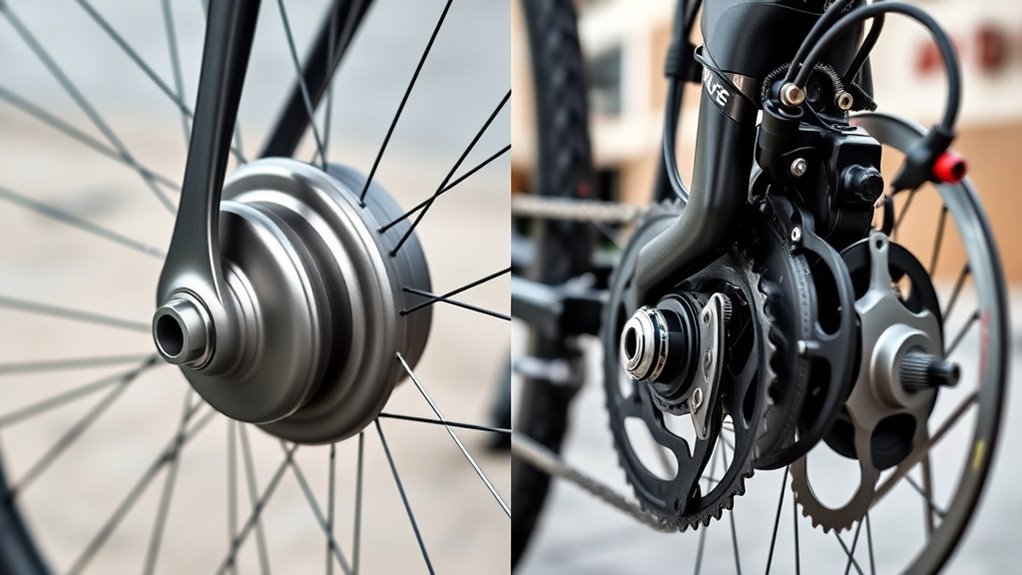
Although both e-bike motor types require regular maintenance, their durability can vary considerably based on design and usage conditions. Hub motors generally have fewer moving parts, making them more durable and easier to maintain, which can positively impact battery longevity. Mid-drive motors, with their complex gear interactions, may face higher repair complexity and wear over time, especially if not maintained properly. Proper lubrication, avoiding excessive heat, and regular inspections help extend motor life. Keep in mind that the quality of components influences how well each motor type withstands daily use. Regular maintenance such as lubrication and inspections is essential for prolonging motor lifespan and ensuring optimal performance.
Choosing the Right Motor for Your Needs
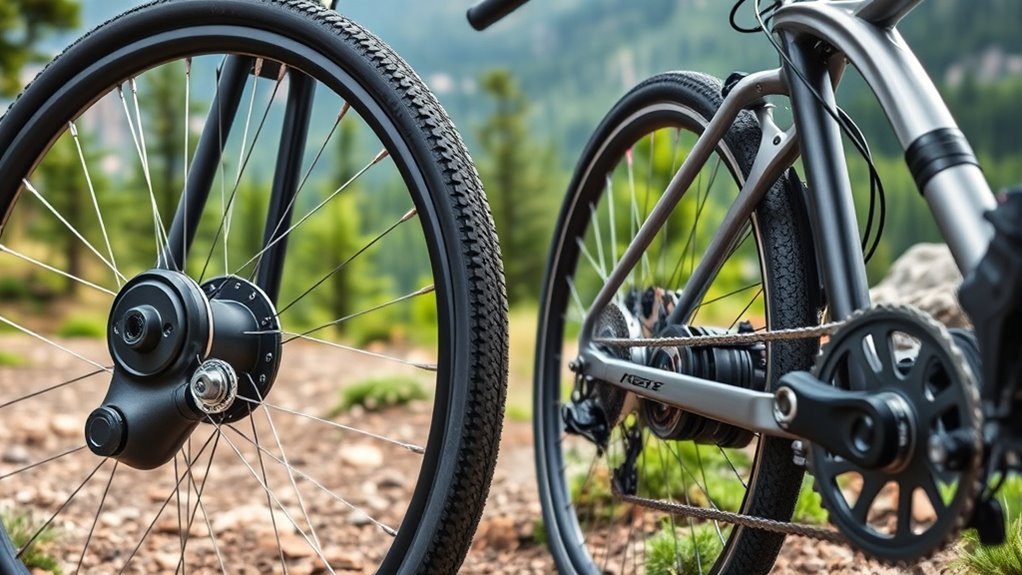
Choosing the right e-bike motor depends on your riding style, terrain, and maintenance preferences. If you prefer a sleek look and easy handling, a hub motor with its battery placement in the wheel offers simplicity and low maintenance. For hilly terrain or frequent climbs, a mid-drive motor with a larger motor size delivers better torque and efficiency. Consider how the motor size impacts power; larger motors provide more assistance but may drain the battery faster. Your riding terrain influences whether you need a compact, lightweight motor or a more robust one for demanding conditions. Motor placement options like hub and mid-drive each have distinct advantages suited to different riding needs. By matching motor type and size to your needs, you guarantee a smoother, more enjoyable ride while optimizing battery life and performance.
Frequently Asked Questions
Which Motor Type Is Better for Mountain Biking?
When choosing the best motor for mountain biking, consider how motor performance and maintenance requirements impact your ride. Mid-drive motors excel with better torque, power transfer, and responsiveness on tough trails, making them ideal for demanding terrains. They do require more maintenance due to their complexity, but their performance benefits often outweigh this. Hub motors are simpler and lower maintenance but may lack the power and responsiveness you need on steep, technical mountain trails.
How Do Motor Types Affect Bike Weight and Handling?
Think of your e-bike as a dance partner; motor weight influences your rhythm and balance. Hub motors are like a heavy backpack, adding weight to the wheels and affecting handling dynamics, making the bike feel more sluggish. Mid-drive motors sit closer to the center, reducing overall weight and improving handling. So, your choice impacts how lively and responsive your ride feels, especially when steering through tricky trails or sharp turns.
Are There Specific Safety Concerns With Hub or Mid-Drive Motors?
When considering safety concerns, you should watch for motor overheating, which can happen with both types if overused or exposed to heat. Hub motors are generally safer for bike stability because they keep the weight centralized, reducing handling issues. Mid-drive motors, while efficient, may impact bike stability if the motor or battery overheats or if you ride aggressively. Always monitor your motor’s temperature and ride within safe limits.
Can I Upgrade My E-Bike Motor Later?
Think of your e-bike as a garden: upgrading the motor is like planting a new flower. You can often explore motor upgrade options, but compatibility considerations are crucial—some motors fit better depending on your bike’s frame and existing components. Before you start, check if your bike’s design permits such upgrades; not all models are easily adaptable. Proper research ensures your upgrade blooms smoothly.
How Do Motor Types Influence Battery Life and Range?
You might notice that motor types impact your e-bike’s battery efficiency and range. Hub motors tend to be more durable and conserve battery power on flat terrain, offering better range. Mid-drive motors, while more powerful, might drain your battery faster, especially on hills or rough terrain. So, consider how your riding style affects motor durability and battery life, helping you choose the best motor type for your needs.
Conclusion
Ultimately, whether you choose a hub or mid-drive motor depends on your riding style and needs. Both options have their strengths, and it’s funny how sometimes, the perfect ride just comes down to understanding these differences. When you realize that the right motor can transform your experience, it feels like everything clicks into place—like you were meant to find that ideal setup all along. Sometimes, the perfect match is just a motor away.
